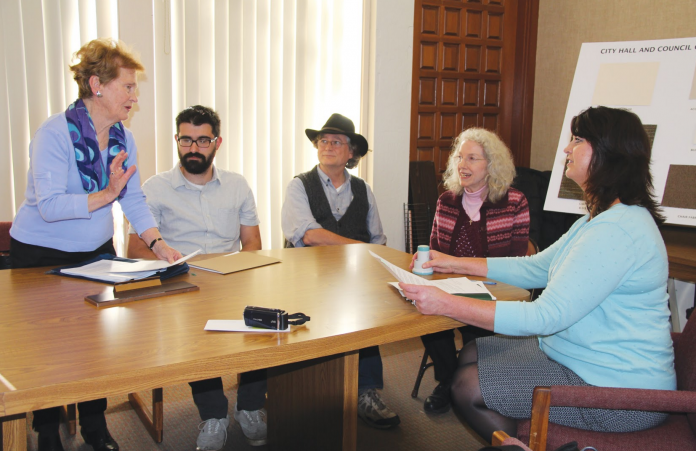In an attempt to avoid sprawl and protect agricultural and open spaces in Gilroy, a citizens action group has taken its first official step toward a ballot measure which, if passed, will establish an urban growth boundary (UGB) for the city and not allow it to grow in most cases, except by a public vote.
On Feb. 18, Gilroy Growing Smarter filed a notice of intent to circulate a petition for the Gilroy Urban Growth Boundary Initiative with City Clerk and elections official Shawna Freels.
As Freels went through the documents, which included the text of the proposed measure, 12 of the group’s members were on hand at City Hall to witness the process. Gilroy Growing Smarter is chaired by former Gilroy councilmember Connie Rogers and co-chaired by union organizer and Gilroy planning commissioner Rebeca Armendariz. Both were excited about their prospects.
“It feels like momentum is with us and we are carrying out the will of the people,” said Rogers. “An urban growth boundary feels like the right answer.”
David Lima, the group’s secretary, explains. “[A UGB] would limit the amount that the city can grow without a public ballot, with certain exceptions.” The exceptions include affordable housing required by state and federal law; parks; public projects such as schools and water treatment facilities; and job-creating industries.
The initiative “to protect the unique character of the city of Gilroy and the agriculture and open space character of the surrounding areas” defines the urban growth boundary as “a line beyond which urban development is not allowed.”
Freels said Feb. 19 that all the documents had been reviewed and certified. Next, they would go to the city attorney, Andy Faber, who has 15 calendar days to produce a ballot title and summary. Once the group receives the ballot title and summary and publishes it in a legally adjudicated newspaper such as the Dispatch, it can begin collecting signatures.
Gilroy Growing Smarter has 180 days from the date it receives the ballot title and summary from the city attorney to collect the approximately 1,923 signatures (10 percent of Gilroy’s registered voters) needed for the measure to make the November ballot.
The group said it’s aiming for “twice that at least.”
While signatures of only registered voters who live in the city of Gilroy will count, any person who is 18 and over and a registered voter can collect signatures.
Once the signatures are collected and certified, the City Council will need to approve funding to cover the election costs, which are dependent on the number of registered voters and the number of items on the ballot.
Freels explained that because it’s a presidential election, which can impact the number of registered voters, as well as the number of agencies consolidating on the ballot, the costs may be uncertain until late summer or early fall.
“We live downtown and are here to advocate for more compact, urban, walkable development downtown and throughout our city,” said David Almeida, a member of both Gilroy Growing Smarter and the city’s Community and Neighborhood Revitalization Committee.
“The amount of undeveloped land within the UGB is more than enough to meet our housing needs until 2040,” said Rogers.
The ballot measure includes a map with a line that cannot be crossed. The boundaries are close to those proposed in the draft 2040 General Plan’s “compact growth” alternative and a plan that was endorsed by citizens attending a community workshop of the General Plan Advisory Commission at Eliot School on Feb. 25, 2015.
A majority of the council, led by former Mayor Don Gage and current Mayor Perry Woodward, voted Dec. 7 to begin implementing key parts of the “orderly growth” alternative in the as-yet-unpassed Gilroy 2040 General Plan. That option would add considerably more housing and more than double the city’s population to as many as 130,000 people, according to projections by city-hired consultants.
Woodward has criticized what he calls “a particularly vocal, activist group” that is “agitated about the council’s long-range planning efforts.”
He said that “allowing large development that happens in stages over time gives the council local control and funding for roads, fire stations, schools, overpasses and the like.”
The 721-acre Rancho Los Olivos development would be prohibited if the initiative qualifies for the ballot and is approved by voters.
Armendariz, who brought her mother, Sally, to watch the Feb. 18 proceedings said her children were fifth-generation Gilroyans and she did not want the city to be planned poorly or be impacted by sprawl. “There is a dichotomy here in Gilroy,” she said. “Lots of parts of the town have been neglected, with city resources going toward the new parts of town. We need to stop and refocus on the people who live here.”
Dan Pulcrano contributed to this report.















